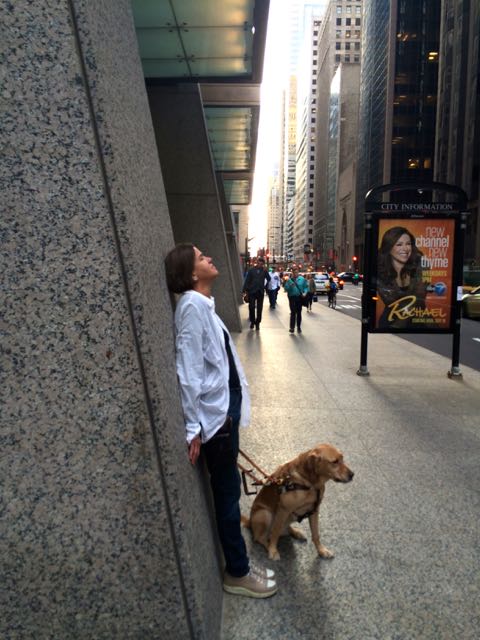A skyscraper tour for the blind. Isn’t that an oxymoron?
In the past, I’ve been ambivalent about special attempts to make visual things more accessible to those of us who can’t see them. I credit the institutions for trying. I really do. And some special accommodations — like the advance tours before plays — have truly enriched my experience. But I couldn’t imagine how the Chicago Architecture Foundation was going to pull off their special walking Must-Hear 25th anniversary tour highlighting, of all things…skyscrapers.
Sighted people have to step back and look up to take in a skyscraper, don’t they? People who are blind might be able to feel the building on the first floor, but I doubted whether people who are blind or have visual impairments could get any perspective, ahem, of a skyscraper without being able to see it.
The sense of touch is nothing like the sense of sight. Touch is too particular. A fingertip can’t possibly take in the grandeur of, say, a 90-story tower.
But, aha! The Chicago Architecture Foundation docents had thought this through. One hearty CAF volunteer pulled a wagon full of substantial building models behind her on the tour. She’d pull the appropriate one out for us to feel as a fellow docent described the building we were standing in front of, and we used other parts of our bodies, not just our fingertips, to explore the buildings themselves:
- The Monadnock building on the corner of Dearborn and Jackson is the tallest load-bearing masonry structure in the world, and we were encouraged to stretch our arms into the windowsills to get a sense of just how thick the load-bearing walls have to be to hold the building up.
- The Marquette Building at Dearborn and Adams was built in 1895, just years after the Monadnock. We used the palms of our hands to feel the cool terra cotta on the exterior, and our docent explained that terra cotta is fireproof. “It was very popular in buildings that went up shortly after the great Chicago fire.”
- A docent described the mosaics on the ceiling in the Marquette Building’s lobby and encouraged each of us to spread our arms and hug one of the Ionic columns at the entrance to get a sense of the grandeur.
- At Federal Plaza, one of the docents suggested we use our foot to trace the border of the blocks at our feet and explained that the entire complex is based on a 28-foot grid pattern using blocks that size. ”The seams of the granite pavers in the plaza extend into the lobbies and up the sides of the Kluczynski Federal Building.”
- At Chase Tower, we leaned back to get a sense of the way the building slants.
So maybe people who are blind can’t get the entire picture of what a skyscraper looks like, but thanks to the Chicago Architecture Foundation’s Must-Hear tour I know a lot more about the history of some of these skyscrapers and why certain materials were used to build them. I often pass by these buildings and plazas on walks with my Seeing Eye dog Whitney, and gee, I may stop in at the Marquette lobby every once in a while to give my ionic column a hug.

At the Marquette Building, did they have you feel the handles on the revolving doors? They’re shaped like tomahawks.
Rats. I missed that. Probably because I was there with Whitney, and we couldn’t fit in the revolving door!
_____
As an architect, Eric would have been happy to know you enjoyed the Chicago Architecture Foundation’s special walking tour, Beth.
…and my memories of Eric’s curiosity and zest for life tell me he would have enjoyed coming along and hugging an ionic column, too!
_____
beth, you have beautiful insight.
And Mary, you write beautiful puns!
_____
This sounds like it was a really great tour! I am very impressed with all of the experiences you have had recently. Kudos to the people who have worked on these projects. I hope the news spreads to more cities across the world!
Amen! I’m heading to another tour put on by the Frank Lloyd Wright Trust tomorrow afternoon — this one at the Robie House in Chicago’s Hyde Park neighborhood. The Chicago Shakespeare Company is doing a touch tour of “The Tempest” tomorrow afternoon, too, but I couldn’t do both. An embarassment of riches!
_____
Do you recall skyscrapers from when you had sight? Did that help you somewhat? It must be different for those who were born without sight, no?
Absolutely different for those who never had sight. Back when I was a teenager in the suburbs and could still see, any time I had a day off from waitressing I’d take the train down to Chicago with a bag lunch and eat it at the First National Bank plaza. There was often free live music there, and when there wasn’t, there was always a lot of people-watching to do. That plaza is now the Chase Tower plaza, right outside that Chase Tower where I am pictured here leaning in the photo on this blog. That building was one of my favorite buildings in Chicago when I was a teenager, I loved the way it swept up into the sky and can still picture it. I never took note of the Marquette Building when I could see, but yes, thanks to the sight I had before, I can imagine how it might look among all the other buildings on Dearborn street. Very astute question.
_____
Beautiful photo, by the way. Thanks for your reply.
What an amazing and informative tour of skyscrapers. I love the inclusion of the materials and using senses to explore the materials, purpose and elements of architecture.
Me, too.
_____
Leave a Response